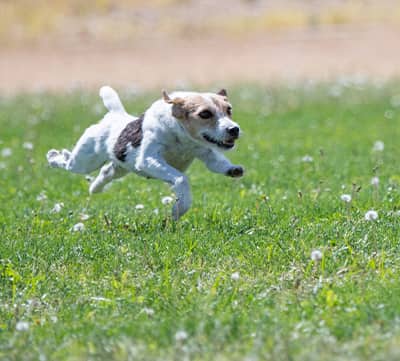Answering the arguments against natural feeding
Raw feeding is an emotive subject and you may be surprised at how many people try to dissuade you from switching your dog to a natural diet. The arguments against raw feeding can be very convincing if you don’t know the real facts, especially as they are often backed up by vets and other experts.
Myth one: Dogs aren’t wolves
One of the main reasons why natural feeding makes such sense is that dogs and wolves are the same species, the only difference being that dogs have been domesticated. It is sometimes suggested that because dogs have been domesticated their physiology and digestive systems have evolved and no longer resemble those of the wolf. Therefore, the argument goes, the idea that they should eat the same diet as wolves (or wild dogs) is wrong. This line of reasoning falls apart both in the bedroom and on the dissecting table! Wolves and dogs can interbreed. The digestive system of a Chihuahua and the digestive system of a wolf are identical in everything but scale. Yes, dogs may have been eating a certain amount of cooked food for the last 8,000–20,000 years but (a) it has only been a percentage of their diet, (b) it has only been a percentage of domesticated dogs and (c) it hasn’t been long enough for them to change the way their bodies digest and absorb nutrients.
The idea (sometimes suggested) that dogs have adapted to processed food since it was invented in 1860 is laughable. It is possible for species to partially adapt to a new diet but palaeontologists believe that it takes at least 100,000 years and probably a great deal longer.
Myth two: Raw food is home to (dangerous) salmonella
You can pretty much ignore anything anyone says to you about the dangers of salmonella poisoning in relation to raw feeding.
Salmonella poses a very, very low risk to humans and an even lower risk to dogs. It is present in 80 to 85% of all raw chicken and yet the number of people who actually suffer from salmonella poisoning is tiny. It is even rarer for a dog to suffer from it and it is interesting to note that when tests were done and dogs were fed infected meat only one-third had any evidence at all of salmonella in their faeces. In other words, the canine stomach acids (which are strong enough to burn your fingers) killed the vast majority of it off.
So, what is salmonella? Salmonella is a bacterium that can cause some unpleasant reactions in our gastrointestinal system, like vomiting and diarrhoea, and often fever. The attack may last about a week. There was some interesting research done in the US which showed that people have a risk of about 0.25% per year of getting infected with salmonella, and 0.05 ppm (ppm = ‘parts per million’) of dying of a salmonella infection. To put this in perspective, this compares to a yearly risk of 108 ppm for a man (33 ppm for a woman) getting murdered, about 100 ppm for getting killed in a car accident and 11 ppm for a person less than 91 years old to die of influenza or pneumonia.
What chance is there of a human catching it from a dog? Dogs do not carry salmonella in their saliva or on their skin, not even after eating 100% salmonella-infected raw food. But, when they do eat salmonella-infected food, about one-third of them will show a moderate concentration of salmonella in their faeces – yet no clinical signs of being sick. The only way a human can catch salmonella from a dog is by, to put it bluntly, eating its you-know-what!
Incidentally, dogs eating a processed food diet are just as likely to have salmonella in their system, as it is easy to pick up in parks and elsewhere.
Human beings have been made paranoid about bacteria. In fact, there are more bacteria on a shopping trolley handle than on a piece of raw chicken.
Myth three: Raw food contains dangerous parasites
In the wild, dogs will usually go for the easiest prey, often animals that are frail and sick. They also eat meat that is rotten, meat that has been buried for weeks and then dug up and, of course, meat that contains parasites. In all these instances they suffer no, or very few, ill effects.
Nevertheless, it is sometimes argued that raw feeding is dangerous to canine and human health because the meat may contain parasites.
This is incorrect for two reasons. First, the food-borne parasites to which dogs are vulnerable do not pose any risk to humans. Second, a dog’s stomach acids are so strong that they destroy almost all known food-borne parasites likely to be of harm to them. If you are still worried about parasites, freeze the food first for at least 24 hours. This will deal with all but a very few, very rare parasites that are never found in food suitable for human consumption.
Myth four: Raw fed dogs are at risk from neospora
Neospora is a very interesting issue, especially as it was only discovered relatively recently. There have been lots of studies on its effect in cattle but there is almost no research in relation to dogs. Neospora is a parasite and, so far, it seems to be very prevalent in beef herds: up to 80% of them are infected. Can it be transmitted from cattle to dogs via meat? If it can, what effect does it have on the dog? Finally, is there any risk to humans? There have been so few cases reported in dogs that there is almost nothing to go on. The dogs that seem most at risk are puppies and dogs with compromised immune systems. It seems to follow the same model as toxoplasmosis and coccidiosis. But there are no properly documented cases of it affecting raw fed dogs. Amongst pro-raw-feeding vets, the basic feeling is that if it were a serious risk we would be hearing a lot more about it. There is no need to worry about this risk, especially as neospora has probably been present in dogs and cattle for hundreds of thousands of years.
Myth five: Raw fed dogs are at risk of renal failure
It has been suggested that feeding a dog bones puts them at risk of renal failure, owing to the high amount of calcium/phosphorous to be found in a natural diet. Calcium is vital to your dog’s health and is the most common mineral in the body. The majority of it (99%) is in the bones, with the rest distributed between other tissues and blood. Calcium has an indispensable role in major bodily functions. It is required for the transmission of nerve impulses. It is required for muscle contraction. It is a vital component in the blood-clotting mechanism. It is the structural component of bones and, hence, is of vital importance in growing animals.
Phosphorous is the other dietary mineral required in a relatively high amount in the diet. About 80% of phosphorus in the body is found in bones and teeth, principally as apatite salts and as calcium phosphate. It is located in every cell of the body. Phosphorus is also intimately involved in the acid base buffer system of blood and other bodily fluids, as a component of cell walls and cell contents as phospholipids, phospho-proteins and nucleic acids. Chronic signs of deficiency include rickets in young animals and osteomalacia in adults, poor growth and lactation performance, and unsatisfactory fertility. Phosphorous is required at levels slightly less than calcium. Meat or organ meats are relatively high in phosphorous but relatively low in calcium.
It is completely wrong to say that raw feeding, eating bones and meat, causes renal failure! To begin with in a well-balanced raw food diet they will be in the correct proportions. Then there is the fact that raw food has lower levels of phosphorous than most canned or dried food. Plus the idea that a high-protein diet increases the chance of renal failure has been pretty much blown out of the water.
Myth six: Raw fed dogs are at risk of choking on bones
Bones, it is suggested, can cause dogs to choke or may rupture the stomach or intestine. In fact, dogs are more than capable of digesting raw, uncooked bones. This is thanks to their strong stomach acids. They are much more likely to choke on dried, processed food, which usually has a water content of between 5 and 10%, far below the 70% water content of a natural diet.
Myth seven: Raw food is covered in bacteria
Yes, raw food is covered in bacteria! But dogs are surprisingly well equipped to deal with it. Their saliva contains lysozyme, an enzyme that destroys harmful bacteria. Their short digestive tract is designed to push through food and bacteria quickly without giving bacteria time to colonise. The extremely acidic environment in the gut is also a good bacteria colonisation deterrent. Incidentally, processed dog food is as much of a risk in terms of bacteria as this quote proves: ‘Pet foods, commercial or homemade, provide an ideal environment for bacterial proliferation’ (LeJuene, J. T. and D. D. Hancock. 2001. Public health concerns associated with feeding raw meat diets to dogs. Journal of the American Veterinary Medical Association 219(9): 1224.). The starches, rancid fats and sugars in kibbled foods provide much better food sources for bacteria than the proteins in raw meat do.
For more information and advice please contact Honey’s – we’ll be happy to help even if you never, ever plan to become a customer.
Web: www.honeysrealdogfood.com
Email: info@honeysrealdogfood.com
Telephone: 01672 620 260







